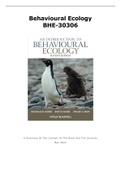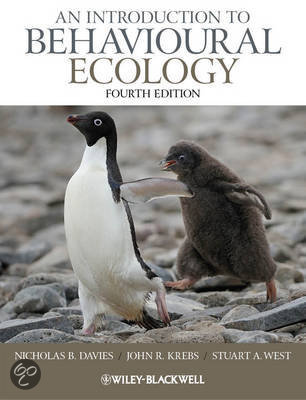Behavioural Ecology
BHE-30306
A Summary Of The Content Of The Book And The Lectures
May 2021
,Lectures – Chapter(s):
1 - 1, 2, 3 (until page 60)
2 - 8
3 - 7
4 - 5 (partly)
5 - 4
6 - 13
7 - 11 (until page 314), 12 (until page 353)
8 - 14
9 - 6
10 - 9
11 - 5 (partly)
,Lecture 1
Evolution: natural selection favours individuals who adopt life-history strategies that maximise
their gene contribution to future generations.
A behaviour or trait that is variable and heritable (or plastic through phenotypic plasticity) must fit
the environment or ecology to have a competitive advantage over others (regarding resources,
survival and reproduction) to be able to have the genes transferred to next generations.
Tinbergen’s 4 why’s: why male starlings sing in spring?
1. Proximate - Causation: the increasing length of day triggers changes in hormones, or
because of the way air flows through the vocal apparatus and sets up membrane
vibrations mechanisms that cause them to sing, like sensory and nervous system.
2. Proximate – Development or Ontogeny: because the starlings have learnt songs from
their parents, and have a genetic disposition to learn the song genetic and
developmental mechanisms.
3. Ultimate – Function: because they attract mates for breeding adaptive advantage.
4. Ultimate – Evolutionary history: because it has evolved from their ancestors.
Proximate: how come an individual behaves that way, causal explanations.
Ultimate: why and how has behaviour evolved, functional explanations why the mechanism is
favoured by natural selection.
Example of 2 observations in lion reproductive behaviour:
Observation Causal explanations Functional explanations
Females are synchronous in Chemical cues? Better cub survival
oestrus Take-overs by males Young males survive better and
have greater reproductive success
when they leave pride if in a
group
Young die when new males Abortion Females come into oestrus more
take over pride Take-over males kill or evict quickly to produce new young
young Male removes older cubs which
would compete with his young
Charles Darwin’s theory of natural selection:
1. Individuals within a species differ in their morphology, physiology, and behaviour
(variation).
2. Some of this variation is heritable.
3. There is competition between individuals for scarce resources.
4. As a result, some variants will leave more offspring than others.
5. If the environment changes, new variants may do best, so natural selection can lead to
evolutionary change.
The modern theory of natural selection with genetic terms:
1. All organisms have genes coding for proteins that regulate development and structure, and
so influences behaviour.
2. Within a population, many genes are present in two or more alleles, which causes
variation.
3. Any allele that results in more surviving copies of itself than its alternatives will eventually
replace the alternative form in the population natural selection is the differential
survival of alternative alleles through their effects on replication success.
For behaviour to evolve:
1. There must be, or have been, behavioural alternatives in the population.
2. The differences must be, or have been, heritable, i.e. genetic origin.
3. Some behavioural alternatives must confer greater reproductive success than others.
, Behaviour of advantage to individuals may be disadvantageous to the group: selfish behaviour.
If a population was to produce more and more offspring because it enhances reproductive success,
at one point they would over-exploit the resources. A system of voluntary birth control for the
good of the group will not evolve because it is unstable. This led to the idea of group selection: a
group consisting of selfish individuals would die out because of over-exploitation. Differential group
survival then results in evolution of behaviour that is good for the
group. However:
1. Group extinction is often not fast enough (not faster than
individual extinction) to be evolutionary important. It’s rather
maximising individual reproductive success (balancing
reproduction and survival trade-offs) that makes them not ever
increasing their birth rate. This can be seen in the optimal
clutch size (figure right): the clutch size that maximizes the
number of young per brood. With increasing clutch size
(benefit), adult mortality increases (cost), so the optimal clutch
size would be where the benefits – costs is biggest.
2. For group selection to work, populations must be isolated, inhibiting migration of selfish
individuals to altruistic populations. This is mostly not the case.
Phenotypic plasticity is the ability of a single genotype to alter its phenotype in response to
environmental conditions. If this variation is continuous, the relationship is called a reaction
norm.
In the figure, different lines
represent different genotypes.
Phenotypic plasticity is present
when the phenotype changes
so the line is not horizontal and
individuals differ in phenotypic
plasticity if the lines do not
have an equal slope.
A scientific approach to understand the function of behaviour involves four stages: observations,
hypotheses, prediction (if my hypothesis is true, my predictions are the following), and tests.
Testing hypothesis can be done in three ways:
1. Comparison between individuals within a species.
2. Experiments: analysing behaviour of the same species in terms of costs and benefits.
3. Comparison among species: how do differences in their behaviour reflect differences in
ecology.
- Problems (things to keep in mind):
o Often explanations for different behaviours are plausible, but you also have to
consider alternative hypotheses.
o Ecological variables must be quantified.
o What is the cause and what is the effect?
o Not all different behaviours are adaptive , they also might be alternative
solutions to the same ecological pressures.
o We need independent data ( use phylogenies and independent contrasts: we
can assume that two species have evolved independently since their
divergence, so the degree of divergence is independent (for ancestors, assume
that values are intermediates of the descendants)) and statistical analyses.
Behaviour involves decision making (e.g. where to search, what to eat) which has costs as well
as benefits. So, to understand variation, we need to understand the trade-off between costs and
benefits. In the end, an individual wants to optimise the fitness costs and benefits. For example,
the number of eggs a bird lays is highly variable, but the bird lays less eggs than one would





